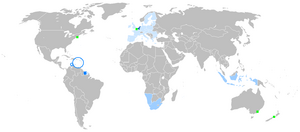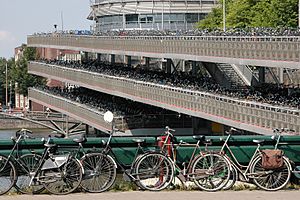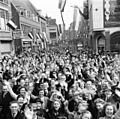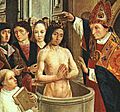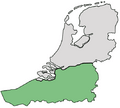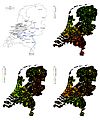Dutch people facts for kids
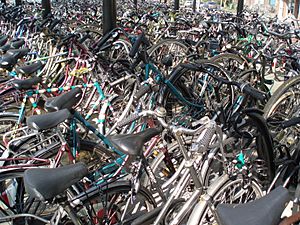
The Dutch are the people who live in the Netherlands, or those that come from the Netherlands. Often the Netherlands is called Holland, but this is only part of the Netherlands. The Dutch culture and ethnicity are also found outside of the Netherlands, with large number of Dutch living in the United States of America, South Africa, Suriname, Namibia.
Many inventors were Dutch, including Hans Lippershey, Hans Janssen, and his son Zacharias Janssen the inventors of the microscope and the telescope, and the incubator. Many famous painters have also been Dutch, among them Rembrandt van Rijn, Vincent van Gogh and Johannes Vermeer.
The definition of ethnicity is not always clear. One can count all people living the Netherlands as Dutch, but many are not. This is because many people who live in The Netherlands were not born there. There are about 15.5 million people in the Netherlands who actually have the Dutch nationality. About 1 million people living in the Netherlands do not have the Dutch nationality. To make things more confusing, people who live in the other parts of the Kingdom of the Netherlands (including Aruba, Curaçao, Sint Maarten, and the Caribbean Netherlands) also have Dutch nationality. Still, even more people in the Netherlands were not born there can also be called "Dutch". According to some definitions, also people who were born in the Netherlands, but who's parents were not, cannot be called Dutch. This definition leaves almost 20% of the entire Dutch population to be 'foreign'.
Demographics
Throughout the world there are about 30 million Dutch people:
| Country | Number of people |
|---|---|
| Netherlands | 16,587,551 |
| USA | 5,087,000 |
| South Africa | ~5,000,000 |
| Canada | 923,000 |
| Australia | 268,000 |
| Germany | 164,000 |
| Belgium | 123,454 |
| France | 83,000 |
| New Zealand | ~50,000 |
| Rest of the world | ~50,000 |
| Total | 33,892,000 |
Population growth
During the last 150 years, the Netherlands saw a relatively quick population growth as compared to the rest of Europe. For comparison: The Belgian population grew from 50% more inhabitants in 1850 to a third less in 2000. The population of the Netherlands grew from 3 million in 1850, to 5 million in 1900, to 10 million in 1950, to 16 million in 2000.
Modern Day Society
The Dutch society in the present can be seen as a very multi-cultural society. About 20% of the entire Dutch population is not of Dutch origin (these people are called allochtoon in Dutch). Even most members of the Dutch Royal family are allochtoon. This comes from the fact that the Netherlands were open to other nationalities and other religions since the beginning of the Republic of the Netherlands (founded in 1588). In the 17th century, it was not odd, for instance for Muslims to live in Amsterdam. After the Second World War, the Dutch hired many workers from Turkey and Morocco to rebuild the Netherlands. Many of these guest workers (gastarbeiders) stayed in the Netherlands. Therefore, The Netherlands have a large Turkish and Moroccan community. Immigration from especially Suriname and Indonesia also led to the multi-cultural society of the present. Recent events (like the murder on Theo van Gogh by a radical Muslim) have led to negative views on allochtonen by some of the Dutch people.
The Dutch society is also famous for its liberal views.
The Netherlands are one of the busiest countries in the world. Almost 16.5 million people live in the little country. That's why not many Dutch live in villages. Most Dutch people live in cities, with a city being a place with at least 25,000 people living there. 8.7 million Dutch live in agglomerations (urban areas which are connected to each other, a sort of metropolitan area). That's about 54% of all the Dutch people. About 15% of the Dutch people live in city's which are not in an agglomeration. The other 30% live in villages (places with less than 25,000 people).
Travel
The Netherlands are a country where bicycles are used very much. Almost 30% of all travel is done by bicycle in the Netherlands. Bicycles are used so much so that throughout the Netherlands hundreds of bicycle parking lots (fietsenstallingen) are built. In Amsterdam, there is even a 3-story high bicycle parking lot. Trains are also used very much (unlike in, for instance, the US). The biggest railway company (NS) has 1.1 million travellers per day. That's 7 percent of the entire Dutch population each day.
Images for kids
-
Dutch people celebrating the liberation of the Netherlands at the end of World War II on 7 May 1945
-
The conversion of the Frankish king Clovis to Christianity would have great significance in helping shape the identity of the future Dutch people.
-
The Act of Abjuration, signed on 26 July 1581, was the formal declaration of independence of the Dutch Low Countries.
-
A typical November scene in the Dutch town Middelburg, Netherlands
-
A comparison of (identical) English, Dutch and German sentences, with IPA symbols added for pronunciation comparison
-
The three largerst patterns of genome-wide SNP variation in the Netherlands
-
Dutch family in Java c. 1903
-
Percentage of Dutch Americans per U.S. county according to the 2000 U.S. Census
See also
 In Spanish: Pueblo neerlandés para niños
In Spanish: Pueblo neerlandés para niños


